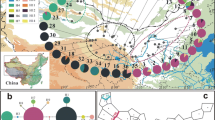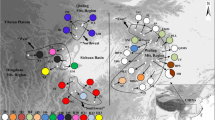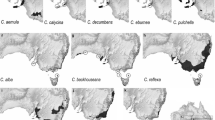Abstract
Molecular studies of plants from the Pacific Northwest of North America suggest a recurrent pattern of genetic differentiation and geographic structuring. In each of five angiosperms and one fern species representing diverse life histories, cpDNA data indicate two clades of populations that are geographically structured. A northern group comprises populations from Alaska to central or southern Oregon, whereas populations from central Oregon southward to northern California form a southern group. In several of these species, a few populations having southern genotypes may have survived in glacial refugia further north in the Olympic Peninsula, Queen Charlotte Islands, and Prince of Wales Island. Allozyme data reveal a similar pattern of differentiation in several other plants from the Pacific Northwest. North-south partitioning of genotypes has also been reported for several animal species from this region. On a broader geographic scale, northsouth partitioning of genotypes has also been observed in other plants from western North America having a variety of geographic distributions. Some species also display a reduction of genetic variability in the northern portion of their range compared to the south. The data suggest strongly that past glaciation profoundly influenced the genetic architecture of the flora and fauna of the Pacific Northwest. Two alternative hypotheses are advanced to explain the geographic structuring of genotypes. First, past glaciation may have created discontinuities in the geographic distributions of plant species, with populations surviving in several well-isolated northern and southern refugia. Following glaciation, migration of genetically differentiated, once-isolated populations resulted in the formation of a continuous geographic distribution with a major genetic discontinuity. Alternatively, plants survived and subsequently migrated northward from a southern refugium, and a genotype became fixed in one or a few populations at the leading edge of recolonization. Subsequent long-distance dispersal from this leading edge resulted in a relatively uniform northern genotype that differs from the southern genotype(s). Whatever the underlying mechanism, Pleistocence glaciation may have molded the intraspecific genetic architecture of both plants and animals from the Pacific Northwest in a geographically similar manner. Future studies should seek to obtain a comprehensive phylogeography for regions that includes a diversity of both plants and animals.
Similar content being viewed by others
References
Allen, G. A., Antos, J. A., Worley, A. C., Suttill, T. A., Hebda, R. J., 1996: Morphological and genetic variation in disjunct populations of the avalanche lilyErythronium montanum. — Canad. J. Bot.74: 403–412.
Avise, J. C., 1986: Mitochondrial DNA and the evolutionary genetics of higher animals. — Philos. Trans. Ser. B312: 325–342.
—, 1989: Gene trees and organismal histories: a phylogenetic approach to population biology. — Evolution43: 1192–1208.
—, 1994: Molecular markers, natural history, and evolution. — New York: Chapman & Hall.
—, 1989: Molecular genetic relationships of the extinct dusky seaside sparrow. — Science234: 646–648.
—, 1979: Mitochondrial DNA clones and matriarchal phylogeny within and among geographic populations of the pocket gopher,Geomys pinetis. — Proc. Natl. Acad. Sci. USA76: 6694–6698.
—, 1984: Characterization of mitochondrial DNA variability in a hybrid swarm between subspecies of bluegill sunfish (Lepomis macrochirus). — Evolution38: 931–941.
—, 1986: Mitochondrial DNA differentiation in North America eel: population genetic consequences of an unusual life history pattern. — Proc. Natl. Acad. Sci. USA83: 4350–4354.
—, 1987: Intraspecific phylogeography: the mitochondrial DNA bridge between population genetics and systematics. — Annual. Rev. Ecol. Syst.18: 489–522.
Brown, J. M., Leebens-Mack, J. H., Thompson, J. N., Pellymr, O., Harrison, R. G., 1997: Phylogeography and host association in a pollinating seed parasite,Greyia politella (Lepidoptera: Prodoxidae). — Molec. Ecol. (in press).
Brown, J. R., Beckenbach, A. T., Smith, M. J., 1992: Influence of Pleistocene glaciations and human intervention upon mitochondrial DNA diversity in White Sturgeon (Acipenser transmontanus) populations. — Canad. J. Fish. Aquatic Sci.49: 358–367.
Calder, J. A., Taylor, R. L., 1968: Flora of the Queen Charlotte Islands. Part 1. Systematics of the vascular plants. — Ottawa: Queen's Printer.
Critchfield, W. B., 1984: Impact of the Pleistocene on the genetic structure of North American conifers. — InLanner, R. M., (Ed.): Impact of the Pleistocene on the genetic structure of North American conifers, pp. 70–118. — Logan, UT: Utah State University.
Cwynar, L. C., MacDonald, G. M., 1987: Geographical variation of lodgepole pine in relation to population history. — Amer. Naturalist129: 463–469.
Daubenmire, R., 1975: Floristic plant geography of eastern Washington and northern Idaho. — J. Biogeogr.2: 1–8.
Demesure, B., Comps, B., Petit, R. J., 1996: Chloroplast DNA phylogeography of the common beech (Fagus sylvatica L.) in Europe. — Evolution50: 2515–2520.
Detling, L. E., 1958: Pecularities of the Columbia River Gorge flora. — Madroño14: 160–172.
Doyle, J. J., Doyle, J. L., Brown, A. H. D., 1990: Chloroplast DNA polymorphism and phylogeny in the B genome ofGlycine subgenusGlycine (Leguminosae). — Amer. J. Bot.77: 772–782.
Elliot-Fisk, D. L., 1988: The boeral forest. — InBarbour, M. G., Billings, W. D., (Eds): North American terrestrial vegetation, pp. 33–62. — New York: Cambridge University Press.
Ferris, C., Oliver, R. P., Davy, A. J., Hewitt, G. M., 1993: Native oak chloroplasts reveal an ancient divide across Europe. — Molec. Ecol.2: 337–344.
Foster, N. J., 1965: The evolution of the mammals of the Queen Charlotte Islands, British Columbia. — Occas. Pap. British Columbia Prov. Mus. no. 14.
Furnier, G. R., Adams, W. T., 1986: Geographic patterns of allozyme variation in Jeffrey pine. — Amer. J. Bot.73: 1009–1015.
Green, D. M., Sharbel, T. F., Kearsley, J., Kaiser, H., 1996: Postglacial range fluctuation, genetic subdivision and speciation in the western North American spotted frog complex,Rana pretiosa. — Evolution50: 374–390.
Harris, A. S., 1965: Subalpine fir on Harris Ridge near Hollis, Prince of Wales Island, Alaska. — NorthW. Sci.39: 123–128.
Heusser, C. J., 1960: Late-Pleistocene environments of North Pacific North America. — Amer. Geogr. Soc. Misc. Publ.35.
—, 1989: North Pacific coastal regugia — the Queen Charlotte Island in perspective. — InScudder, G. G. E., Gessler, N., (Eds): The outer shores, pp. 91–106. — Queen Charlotte Islands, B. C.; Queen Charlotte Island Museum Press.
Hewitt, G. M., 1993: Postglacial distribution and species substructures: lessons from pollen, insects and hybrid zones. — InLees, D. R., Edwards, D., (Eds): Evolutionary patterns and processes, pp. 97–123. — London: Academic Press.
Hosaka, K., Hanneman, R. E. Jr., 1988: Origin of chloroplast DNA diversity in the Andean potatoes. — Theor. Appl. Genet.76: 333–340.
Hultén, E., 1968: Flora of Alaska and neighboring territories. — Stanford, CA: Stanford University Press.
Johnson, P. J., 1987: Larval taxonomy, biology, and biogeography of the genera of the North AmericanByrrhidae (Insecta:Coleoptera). — M. Sc. Thesis, Department of Plant, Soils, and Entomological Science, University of Idaho, Moscow, USA.
Konnert, M., Bergmann, F., 1995: The geographical distribution of genetic variation of silver fir (Abies alba, Pinaceae) in relation to its migration history. — Pl. Syst. Evol.196: 19–30.
Lavin, M., Mathews, S., Hughes, C., 1992: Chloroplast DNA variation inGliricidia sepium (Leguminosae): intraspecific phylogeny and tokogeny. — Amer. J. Bot.78: 1576–1585.
Lewis, P. O., Crawford, D. J., 1995: Pleistocene refugium endemics exhibit greater allozymic diversity than widespread congeners in the genusPolygonella (Polygonaceae). — Amer. J. Bot.82: 141–149.
Liston, A., Rieseberg, L. H., Hanson, M. A., 1992: Geographic partitioning of chloroplast DNA variation in the genusDatisca (Datiscaceae). — Pl. Syst. Evol.181: 121–132.
Lorain, C. C., 1988: Floristic history and distribution of coastal disjunt plants of the northern Rocky mountains. — M. Sc. Thesis, College of Forestry, Wildlife and Range Science, University of Idaho, Moscow, USA.
Mercure, A., Ralls, K., Koepfli, K. P., Wayne, R. K., 1993: Genetic subdivision among small canids: mitochondrial DNA differentiation of swift, kit, and arctic foxes. — Evolution47: 1313–1328.
Mitton, J. B., 1994: Molecular approaches to poulation biology. — Annual Rev. Ecol. Syst.25: 45–69.
Moody, M. E., Mueller, L. D., Soltis, D. E., 1993: Genetic variation and random drift in autotetraploid populations. — Genetics134: 649–657.
Muller, F. B., 1977: Fluctuations of glaciers, 1970–1975 (v.3). — Paris: International Commission on Snow and Ice of the International Association of Hydrological Sciences.
Novak, S. J., Soltis, P. S., 1991: Intraspecific cpDNA variation in four species ofLomatium (Umbelliferae). — Amer. J. Bot.78 (Suppl.): 207.
O'Reilly, P., Reimchen, T. E., Beech, R., Strobeck, C., 1993: Mitochondrial DNA inGasterosteus and Pleistocene glacial refugium on the Queen Charlotte Islands, British Columbia. — Evolution47: 678–684.
Parks, C. R., Wendel, J. F., Sewell, M. M., Qiu, Y.-L., 1994: The significance of allozyme variation and introgression in theLiriodendron tulipifera complex (Magnoliaceae). — Amer. J. Bot.81: 878–889.
Pielou, E. C., 1991: After the ice age: the return of life to glacinated North America. — Chicago: The University of Chicago Press.
Pojar, J., 1980: Brooks Peninsula: possible Pleistocene glacial refugium on northwestern Vancouver Island. — Botany 80 Conference. — Bot. Soc. Amer. Misc. Ser. Publ.158: 89.
Rieseberg, L. H., Soltis, D. E., 1987: Allozymic differentiation betweenTolmiea menziesii andTellima grandiflora (Saxifragaceae). — Syst. Bot.42: 227–238.
Sage, R. D., Wolff, J. O., 1986: Pleistocene glaciations, fluctuating ranges, and low genetic variability in a large mammla (Ovis dalli). — Evolution40: 1092–1095.
Sewell, M. M., Parks, C. R., Chase, M. W., 1996: Intraspecific chloroplast DNA variation and biogeography of North AmericanLiriodendron L. (Magnoliaceae). — Evolution50: 1147–1154.
Smith, J. P., Sawyer, J. O., Jr., 1988: Endemic vascular plants of northwestern California and southwestern Oregon. — Madroño35: 54–69.
Soltis, D. E., Kuzoff, R., 1995: Discordance between nuclear and chloroplast phylogenies in theHeuchera group (Saxifragaceae). — Evolution49: 727–742.
—, 1989: Genetic consequences of autopolyploidy inTolmiea menziesii (Saxifragaceae). — Evolution43: 586–594.
—, 1989: Chloroplast DNA variation in a wild plant,Tolmiea menziesii. — Genetics121: 819–826.
—, 1991: Chloroplast DNA variation inTellima grandiflora (Saxifragaceae). — Amer. J. Bot.78: 1379–1390.
—, 1992a: Intraspecific cpDNA variation: systematic and phylogenetic implications. — InSoltis, P. S., Soltis, D. E., Doyle, J. J., (Eds): Molecular systematics of plants, pp. 117–150. — New York: Chapman & Hall.
—, 1992b: Geographic structuring of chloroplast DNA genotypes inTiarella trifoliata (Saxifragaceae). — Pl. Syst. Evol.181: 203–216.
Soltis, P. S., Soltis, D. E., 1987: Population structure and estimates of gene flow in the homosporous fernPolystichum munitum. — Evolution41: 620–629.
Soule, J. A., Soltis, D. E., Soltis, P. S., 1995: Geographic patterns of chloroplast DNA variation inRibes bracteosum (Grossulariaceae). — Amer. J. Bot.82: 164.
Steele, R. W., 1971: Red Alder habitats in Clearway County, Idaho. — M. Sc. Thesis, College of Forestry, Wildlife and Range Science, University of Idaho, Moscow, USA.
Steinhoff, R. J., Joyce, D. G., Fins, L., 1983: Isozyme variation inPinus monticola. — Canad. J. Forest. Res.13: 1122–1132.
Strenge, D., 1994: The intraspecific phylogeography ofPolystichum munitum andAlnus rubra. — M. Sc. Thesis, Washington State University.
Thorgaard, G. H., 1983: Chromosomal differences among rainbow trout populations. — Copeia3: 650–662.
Waitt, R. B., Thorson, R. M., 1983: The Cordilleran ice sheet in Washington, Idaho and Montana. — InWright, H. E. Jr., (Ed.): Late-Quaterly environments of the United States1, pp. 53–70. — Minneapolis: University of Minnesota Press.
Warner, N. G., Mathewes, R. W., Clague, J. J., 1982: Ice-free conditions on the Queen Charlotte Islands, British Columbia, at the height of the late Wisconsin glaciation. — Science218: 675–677.
Wells, T. C., Bohm, B. A., 1994: Isozyme variation in North AmericanMenziesia (Ericaceae). — Syst. Bot.19: 407–423.
Wheeler, N. C., Guries, R. P., 1982: Populations structure, genic diversity, and morphological variation inPinus contorta Dougl. — Canad. J. Forest Res.12: 595–606.
Whittaker, R. H., 1961: Vegetation history of the Pacific Coast states and the “central” significance of the Klamath region. — Madroño16: 5–17.
Worley, I. A., Jacques, D., 1973: Subalpine fir (Abies lasiocarpa) in coastal western North America. — NorthW. Sci.47: 265–273.
Zink, R. M., Dittmann, D. L., 1993: Gene flow, refugia, and evolution of geographic variation in the song sparrow (Melospiza melodia). — Evolution47: 717–729.
Author information
Authors and Affiliations
Additional information
Dedicated to emer. Univ.-Prof. DrFriedrich Ehrendorfer on the occasion of his 70th birthday
Rights and permissions
About this article
Cite this article
Soltis, D.E., Gitzendanner, M.A., Strenge, D.D. et al. Chloroplast DNA intraspecific phylogeography of plants from the Pacific Northwest of North America. Pl Syst Evol 206, 353–373 (1997). https://doi.org/10.1007/BF00987957
Received:
Revised:
Accepted:
Issue Date:
DOI: https://doi.org/10.1007/BF00987957




